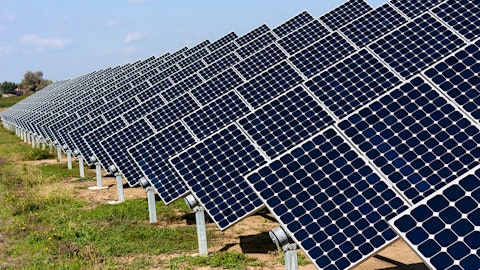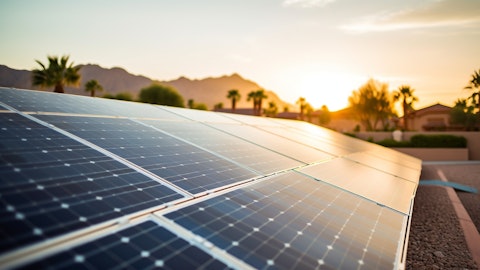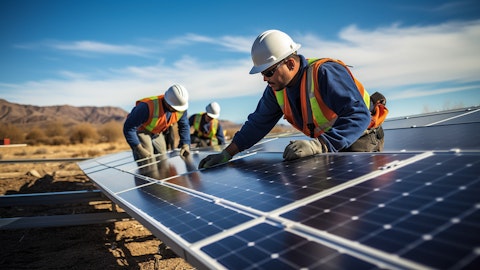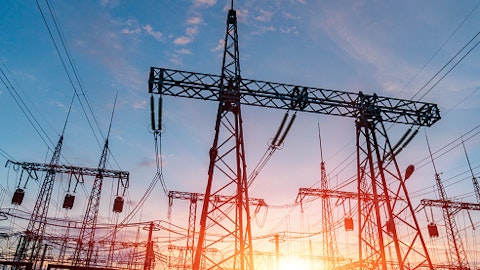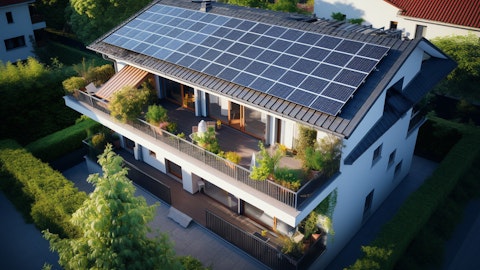So, we’re feeling good about our position. We think that our position is somewhat unique relative to what’s going on in the landscape. And for sure, the current environment should lend itself to higher return opportunities.
Andrew Percoco: Great. Thank you.
Operator: Our next question comes from the line of Justin Clare with ROTH MKM. Please proceed with your question.
Justin Clare: Hi, everyone. Thanks for taking questions here.
Lars Norell: Absolutely. Welcome.
Justin Clare: So, first off, I did want to ask about Q4. Just wondering how much lower was the generation in the quarter versus what you would typically expect historically. What’s the difference between the historical norm? And then, was the issue only really weather-related in terms of the performance of the operating assets or was there any system availability issue as well? And then I guess, finally, on that same point is, how do you consider weather and the generation of the assets in your 2024 guidance? How did you think about that?
Dustin Weber: Hey, Justin, this is Dustin. I’ll start in on that one. So yes, 2023, we tackled a number of variables, continued supply chain disruptions, particularly as it relates to transformers and switch gears, continued slowness by utilities on completing interconnections. Gregg referenced the new paradigm of higher interest rate environment. And so there’s some challenges there. I would say, weather is one that – variable that we couldn’t mitigate, and it was the primary driver for our financial results falling short of target in ‘23. The other main contributor was that we expected more revenue contribution from new assets added in Q4. Q4 was one of our best quarters ever in terms of adding new megawatts between new builds and assets in operation.
We added a 175 megawatts, the vast majority of those projects, including the Basalt acquisition, came on very late in December, and therefore, it didn’t contribute much to our Q4 revenue. That said, completing those is huge for us and setting us up for ‘24 and we’re going to get a full year revenue in ‘24 from those. So, overall, I would say those were the two primary drivers. So, we feel very good about how we positioned ourselves for 2024. We do expect more normalized sunlight hours than we got in 2023. And so, we’re feeling good about that.
Justin Clare: Okay, appreciate it. And then, was wondering if you could just also talk about just where you see time lines for projects today. So, from the time you sign a contract, how long would you typically anticipate before you can complete construction? Is that extending? Is it being pulled forward? And then I know you’re talking about expanding your workforce. Do you see an opportunity to kind of bring timelines in as you expand your workforce and the construction capabilities?
Lars Norell: Hey, Justin, this is Lars. So I’ll take that question. Just to start where you ended. Absolutely, the intention with growing our platform is, of course, to use a larger team, whether it’s engineering or design or construction or construction supervision, to overcome whatever challenges exist in the market with respect to building departments or utility interconnection queues or whatever the case might be. So, the answer to the first part is, it varies significantly by market. And it varies, of course, also, if you look at our pipeline, if it’s a self-originated deal where we’ve done all the work ourselves, in normal timelines might be 12, 15 or 18 months. In some markets, we’re able to do better than that right now.
In often case, we’re able to do better if it’s behind the meter solar system so that we don’t have to wait for some utility community solar program to open up in exactly the right way. When it is a community solar program, for example, in some of the states on the East Coast, they have been a little slower to open, and they’ve been a little smaller in terms of their aperture for what system sizes can be submitted into them. And whenever that happens, assets that we’ve already signed leases for with clients, they’re still there, but they just get pushed out to the right. So instead of being able to build those assets and be done with them in, say, October of this year, we might currently predict that we’re going to be done with them in February of next year, or whatever the case might be.
We continue to grow our platform to overcome these challenges. We, like Gregg said, are expecting to build more new-build assets next year than we did this year. The time lines for deals that we take over from channel partners, where they might have done most of the development work, continue to be much shorter. In those cases, we might be looking at sort of a 9 to 12-month construction period instead of 12 to 15. And so, between the different markets and the different sources of deal flow and a growing platform, we feel pretty good about where we are in spite of some of the challenges with timing from utilities and some programs.
Justin Clare: Okay, I appreciate it. Thank you.
Operator: Thank you. Our next question is from the line of Vikram Bagri with Citi. Please proceed with your questions.
Vikram Bagri: Hey, good afternoon, everyone. I wanted to start with ARR and put some numbers around the previous question on the call. If I assume a 60% EBITDA margin on the year-end ARRs that you disclosed about $183 million, it seems like at year-end, the EBITDA run rate was around $110 million. So you added about $31 million of EBITDA in 2023. Did this implies that EBITDA addition was at like $72,000 per megawatt, which seems low relative to what your target has been historically, about $100,000 to $150,000 per megawatt of EBITDA added. I wanted to make sure I understand this right and what the factors behind that are. Couple of things that come to mind is perhaps the SG&A was somewhat understated at the end of year-end 2022.
Perhaps the EBITDA per megawatt added in ‘23 was slightly lower. Maybe you’ve changed the irradiance assumptions that you have in calculation of the EBITDA and/or SREC prices are having an impact on the EBITDA as well. So, wondering like if you can help us understand and help us bridge that gap between EBITDA per megawatt that you add on organic growth and M&A.
